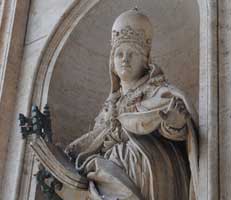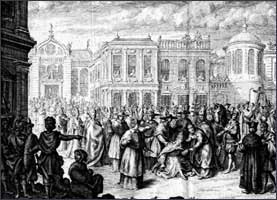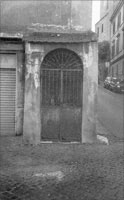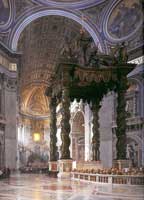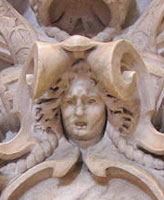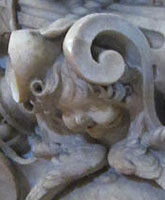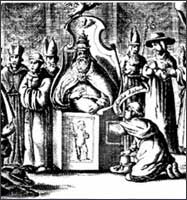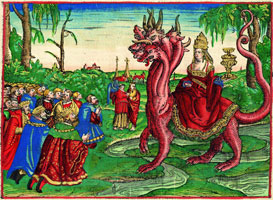BRITISH BORN POPE JOAN REIGNED AS PONTIFF FROM 855 TO 857 AD. SHE WAS THE PRECURSOR OF QUEEN ELIZABETH I, QUEEN VICTORIA, AND THE TWINS!! |
Pope Joan's parents were Anglo-Saxons who were sent from England to destroy the work of the Irish missionaries in Germany.
Since the days of Pope Boniface (680 – 754), Anglo Saxon monks followed the Irish missionaries in order to destroy the good seed of the Gospel sown by the spiritual descendents of Saint Patrick.
Joan was a child prodigy, with a gift for languages, and she quickly mastered Latin and Greek. In 830, when she was about 15, she met a monk from the Benedictine monastery at Fulda in Germany.
Joan fell in love with the monk, but he could not marry her due to the diabolical Latin canon law of celibacy. In order to be close to her lover, she disguised herself as a man, and entered the Benedictine monastery as a male. Joan the Englishwoman became John Anglicus or John the Englishman.
About that time, the Benedictines were creating the new languages of Italian, French, and Spanish, so Joan's proficiency in languages was very much appreciated.
Joan's shapely figure was hidden by the monk's cowl, and since the monks rarely took baths, she was able to live among them incognito for several years.
One day Joan became very sick, but before the monastery "physician" had a chance to examine her, she fled from the monastery with her lover. Eventually, they settled in Athens, Greece.
In Athens, Joan became very familiar with the raging controversy surrounding the worship of images and the dispute concerning the filioque. She was very adept at defending the Latin position on these vital issues.
Around 847, Joan separated from her lover, who went East in search of wisdom, and Joan moved to Roma. She/he soon gained fame in Roma because of her knowledge of Greek and her skill at defending the worship of images. When Pope Leo IV died in 853, she was elected Pope.
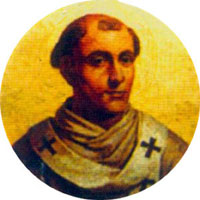 Pope Leo IV (847–855). |
|
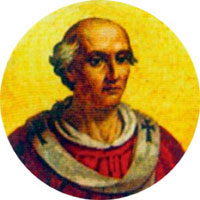 Pope Nicholas I (800–867). Pope from 858 to 867. |
When Joan/John arrived in Rome from Athens about 847, she soon gained fame as a controversialist and as a defender of the new Latin innovations such as the worship of images and the filioque. This led to her election to the Papacy in 853.
|
t is not beyond belief that a woman should be Pope because the Latin Vulgate says that the Messiah is female. When Satan caused Adam and Eve to sin, JEHOVAH promised to send a Messiah that would crush his head. This prophecy predicted the virgin birth of the Messiah:
And I will put enmity between thee and the woman, and between thy seed and her seed; he shall bruise thy head, and thou shalt bruise his heel (Genesis 3:15).
The Latin Vulgate Version changed the word HE to SHE:
I will put enmities between thee and the woman, and thy seed and her seed: she shall crush thy head, and thou shalt lie in wait for her heel (Genesis 3:15, Douay-Rheims Version).
Pope Joan was surrounded by ambitious fawning sycophants, and one of them became her lover. Some historians say that her former lover returned from the East and resumed their relationship; but whoever it was, Pope Joan became pregnant.
|
A shrine with a statue commemorating the female Pope was placed on the exact spot where she gave birth. It is still called the Vicus Papissa. It is ironic that Pope Joan's pontificate ended on the 100th anniversary of the temporal power of the Papal Pontiffs.
A laborious delivery in "St. Peter's" basilica!!
Pope Urban VIII (1623-1644) commissioned Gian Lorenzo Bernini to design the special baldacchino or canopy in "St. Peter's" basilica.
2 of the massive columns are decorated with 8 coat of arms of the Pope. 7 of them show a woman in childbirth, and the 8th shows the successful delivery of a smiling happy baby.
|
The 7 crests represent Pope Joan in childbirth, but they also depict a woman in labor to deliver the last Antichrist:
And the beast that was, and is not, even he is the eighth, and is of the seven, and goeth into perdition.
(Apocalypse 17:11).
After a painful childbirth, the woman in "St. Peter's" basilica has a successful delivery.
|
Usually babies are crying at childbirth, but this baby is smiling and happy, because he represents Satan, who is delighted at the prospect of taking millions of people with him into the lake of fire and brimstone!!
Saint Paul compared the Second Coming of Christ to a woman giving birth to a baby:
But of the times and the seasons, brethren, ye have no need that I write unto you. For yourselves know perfectly that the day of the Lord so cometh as a thief in the night. For when they shall say, Peace and safety; then sudden destruction cometh upon them, as travail upon a woman with child; and they shall not escape (I Thessalonians 5:2-3).
According to the surviving accounts, Pope Joan died in childbirth, but nobody knows what happened to the baby. The next Pope named John after Pope Joan VIII should have been called John IX, but the mistake wasn't remedied until 1276, when Portuguese Pope John XXI skipped the number XX.
The sedia stercoraria or the sex check chair!!
After the deceivers were deceived by Pope Joan, a special chair was designed to make sure that there would be no more female Popes. This was definately not the chair of the humble presbyter Saint Peter; who was male, wore a beard, and never visited Rome once.
|
The only Pope who really had the pontificals was Pope Clement XIV, who found the courage to ban the Jesuits permanently and perpetually.
With the coming of the Jesuits and the Counter-Reformation, the statue of Pope Joan was removed from the Vicus Papissa, and the public ceremony of the sedia stercoraria was discontinued.
The Jesuits did their utmost to hide the existence of Pope Joan . . . but the facts of history cannot be easily erased.
Saint Martin Luther saw the statue of Pope Joan in Roma!!
Saint Martin Luther, in his Table Talk, states that he saw a commemorative statue of Pope Joan when he visited Roma in 1510:
In Rome, in a public square, there is a stone monument to commemorate the pope who was really a woman and gave birth to a child on that very spot. I have seen the stone myself, and I find it astonishing that the popes permit it to exist. (Luther, Table Talk, p.133).
When Saint Martin was excommunicated by Pope Leo X, he saw for the first time that Roma was indeed the scarlet harlot of the Apocalypse.
|
The statue of the female Pope was without doubt a great visual aid in helping him understand the symbols in the Book of Revelation:
So he carried me away in the spirit into the wilderness: and I saw a woman sit upon a scarlet coloured beast, full of names of blasphemy, having seven heads and ten horns. And the woman was arrayed in purple and scarlet colour, and decked with gold and precious stones and pearls, having a golden cup in her hand full of abominations and filthiness of her fornication: And upon her forehead was a name written, MYSTERY, BABYLON THE GREAT, THE MOTHER OF HARLOTS AND ABOMINATIONS OF THE EARTH (Apocalypse 17:3-5).
Soon after Saint Martin Luther wrote The Babylonian Captivity of the Church, he was summoned to Roma to answer for his "heresy." He never obliged Pope Leo X because he knew that the only fate awaiting him at Roma was burning alive at the stake!!
The Holy Bible says that women ruling over men is an abomination!!
At the very beginning of history, when Adam and Eve sinned in the Garden of Eden, JEHOVAH told Eve that Adam would from then on rule over her:
To the woman also he said: I will multiply thy sorrows, and thy conceptions: in sorrow shalt thou bring forth children, and thou shalt be under thy husband's power, and he shall have dominion over thee (Genesis 3:16, Douay-Rheims Version).
When Israel departed from JEHOVAH, women ruled over them:
As for my people, children are their oppressors, and women rule over them. O my people, they which lead thee cause thee to err, and destroy the way of thy paths (Isaiah 3:2).
Before the Coming of the Messiah, Satan's religion of paganism dominated the entire world. Demons masqueraded as females, and every nation had its female goddess. When Saint Paul was preaching the Gospel, his main enemy was this female goddess:
But when they knew that he was a Jew, all with one voice about the space of two hours cried out, Great is Artemis of the Ephesians. And when the townclerk had appeased the people, he said, Ye men of Ephesus, what man is there that knoweth not how that the city of the Ephesians is a sacristan of the great goddess Artemis, and of the image which fell down from Zeus? (Acts 19:34-35, Greek Orthodox Version).
But I do not permit a woman to teach, nor to usurp authority over the man, but to be in silence. (I Timothy 2:12).
After his stoning at Lystra, Saint Paul was caught up to the 3rd heaven, and he was shown the future of Christianity from his day to the end of time. He knew that Satan would create a false religion at Rome, with a woman riding a 7 headed, 10 horned beast.
The Messiah issued the same stern warning against women teachers to the Apostle John on the Isle of Patmos:
Notwithstanding I have a few things against thee, because thou sufferest that woman Jezebel, which calleth herself a prophetess, to teach and to seduce my servants to commit fornication, and to eat things sacrificed unto idols (Apocalypse 2:20).
The last message from JEHOVAH to his Congregation is a passionate plea to males and females to come out of Babylon:
And I heard another voice from heaven, saying, Come out of her, my people, that ye be not partakers of her sins, and that ye receive not of her plagues (Apocalypse 18:5).
Vital link
A laborious delivery in "St. Peter's" basilica
References
Cross, Donna Woolfolk. Pope Joan. Crown Publishers, New York, 1996.
Luther, Martin. Table Talk. William Du-gard, London, 1652.
Rappaport, Angelo S. The Love Affairs of the Vatican. Barnes & Nobles Books, New York, 1995. (Originally published in 1912).
Stanford, Peter. The Legend of Pope Joan. Berkley Books, New York, 1998.
Wood, Clement. The Woman Who Was Pope. William Faro, Inc., New York, 1931.
Copyright © 2020 by Patrick Scrivener

